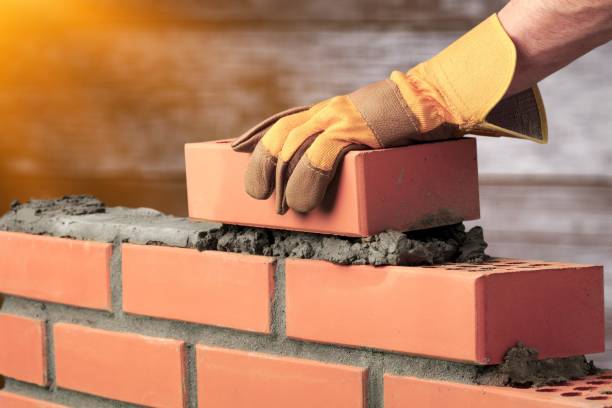The Main Principles Of Bricklayer Auckland
Wiki Article
The Definitive Guide to Bricklayer Auckland
Table of ContentsThe Bricklayer Auckland PDFsThe Best Guide To Bricklayer AucklandWhat Does Bricklayer Auckland Do?Some Of Bricklayer Auckland
The distinction between Absolutely no and classic masonry is in the laying of the block. The brick is no much longer pushed vertically, but slanted.In addition, we additionally paid focus to a great percentage in between the size as well as size of the brick so that it is excellent for functioning with a cot bond. Bricklayers are an essential occupation in the building industry, liable for laying blocks, pre-cut rock and also concrete blocks in mortar. Bricklayers construct, expand and fix domestic as well as business buildings, as well as various other frameworks such as structures, walls, smokeshafts or ornamental masonry.
Your time as a bricklaying pupil will usually be divided between your company and training carrier (such as a college), with at the very least 20% of your typical functioning hours invested in training. Your training could occur every week, on a monthly basis or in a separate block of time, and also it can occur at your place of work, at your training carrier or online.
The smart Trick of Bricklayer Auckland That Nobody is Discussing
When investigating construction, you inevitably discover that any kind of new or ingenious suggestion has in fact been attempted over and over again, frequently extending back years. One of these new-but-actually-old ideas is the suggestion of a mechanical bricklayer, a device to automate the building of stonework walls. It's easy to see the appeal of this concept - stonework building and construction seems practically perfectly fit for automation.It does not seem like it would require physically complicated motions - each brick gets a layer of mortar used, and also is simply stocked area following to the previous one. As well as because each physical joint is the very same dimension, positioning is nearly deterministic - each brick coincides set distance from the previous one.
These machines couldn't sense anything about their setting, or step where a brick required to go - they simply extruded a layer of mortar as well as mechanically positioned a brick at normal intervals (Bricklayer Auckland). It's uncertain the amount of of these machines ever made it beyond the drawing board, yet a minimum of one of these (John Knight's) was utilized to build a block wall surface that apparently still stands today.
Throughout the years, masonry has declined in value as a building and construction innovation in the industrialized globe, as well as with it the interest in automating it. Unlike with concrete 3D printing, where there are lots of efforts to develop the technology, I can only find a handful of current efforts to automate stonework. Bricklayer Auckland.
The Buzz on Bricklayer Auckland
It can placing blocks in tight hallways or complicated corners, as well as Hadrian can construct all the wall surfaces of a tiny building with just a couple of steps of the automobile. Hadrian can presently establish around 200 obstructs an hour, however they're click now intending to be able to do 1000 blocks an hour or more (the blocks it sets are various from the block masonry made use of in the US, yet in United States masons can set somewhere in the neighborhood of 400 blocks a day).
SAM has a collection of sensors to compensate for the activity of the platform and also guarantee it's placing bricks degree, and also can collaborate with bricks of all different sizes (though it won't construct CMU block wall surfaces). It gets mounted to a movable scaffolding that's raised progressively as the wall surface is completed.
The promotional material on Building and construction Robotics' web site suggests that it's no longer their major focus - more focus is given to their other item, MULE.Other than SAM and Hadrian, there are a couple of other mechanical bricklayers in various phases of development. You likewise see the periodic academic initiative. One location where we do see some industrial success with mechanical bricklaying is with block roadways - a range of companies offer devices that can "publish" a section of roadway made of bricks.
The Best Guide To Bricklayer Auckland
A slightly different classification of machines intended at boosting stonework performance is what I'll call "masonry assistants". These are devices made to help with literally lifting the block (they appear to be extra typical with block than brick) as well as taking the pressure off the mason, while still enabling the mason to adjust it right into position, Stonework aides day from read this article at the very least 1994, when the armed forces trying out MOTHER, the Mechatronically Assisted Mason's Help.
Report this wiki page